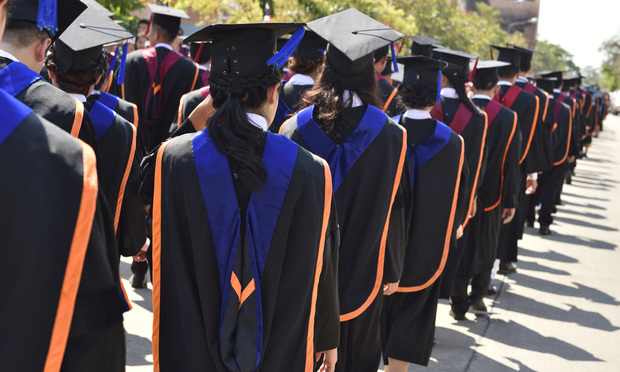Law Grads Hiring Report: Job Stats for the Class of 2017
The law class of 2017 overall fared better in the entry-level job market, but national figures obscure the extreme stratification of employment success for grads from individual schools. Our 10 charts break down all the latest hiring data, showing the schools that excelled—and those that lagged behind.
April 25, 2018 at 01:38 PM
3 minute read
The original version of this story was published on Law.com
The American Bar Association this month released new law school employment data that showed the class of 2017 fared better in the entry-level job market than its recent predecessors.
Within 10 months of leaving law school, 75.3 percent of 2017 graduates landed full-time, long-term jobs that require bar passage or for which a law degree offers an advantage. Those results are up from 72.6 percent for the class of 2016.
But national figures don't offer a clear picture of how individual law schools do in helping their graduates secure jobs. We've waded through the ABA's trove of employment numbers to break down how schools performed in 10 different areas, including sending graduates into jobs for which bar passage is a requirement; into federal clerkships; into large firm jobs; and government and public interest positions. We've also ranked schools according to their percentage of unemployed recent graduates, as well as each school's underemployment rate—which includes graduates who are unemployed, in part-time or short-term jobs, or in non-professional jobs.
Our charts illustrate how stratified legal education is when it comes to graduate employment. For instance, seven law schools sent 90 percent or more of their 2017 graduates into full-time law jobs that require bar passage, largely considered the gold standard for law jobs. (They were led by Duke Law School, at nearly 94 percent.) On the other end of the spectrum, 12 schools sent fewer than 40 percent of their recent graduates into those positions. (Thomas Jefferson School of Law reported the lowest percentage outside of Puerto Rico, at less than 26 percent.)
➤➤ Stay on top of developments and trends in legal education with Ahead of the Curve by Karen Sloan, a new weekly briefing from Law.com. Sign up here and get next week's email update straight to your inbox.
We've also added a new category this year: elite jobs—the percentage of recent graduates in federal clerkships and law firms of 100 or more attorneys. We report each of these categories separately as well, but the combination offers a look at which schools are sending graduates on to some of the most competitive and sought after jobs in the legal industry. Columbia Law School posted the highest percentage of 2017 graduates in BigLaw, but Chicago took the top spot on the Elite Jobs list due to its strong federal clerkship track record. As usual, Yale Law School tops the federal clerkships list.
To view charts on mobile, turn horizontally.
This content has been archived. It is available through our partners, LexisNexis® and Bloomberg Law.
To view this content, please continue to their sites.
Not a Lexis Subscriber?
Subscribe Now
Not a Bloomberg Law Subscriber?
Subscribe Now
NOT FOR REPRINT
© 2025 ALM Global, LLC, All Rights Reserved. Request academic re-use from www.copyright.com. All other uses, submit a request to [email protected]. For more information visit Asset & Logo Licensing.
You Might Like
View AllTrending Stories
- 1'Digital Mindset': Hogan Lovells' New Global Managing Partner for Digitalization
- 2Silk Road Founder Ross Ulbricht Has New York Sentence Pardoned by Trump
- 3Settlement Allows Spouses of U.S. Citizens to Reopen Removal Proceedings
- 4CFPB Resolves Flurry of Enforcement Actions in Biden's Final Week
- 5Judge Orders SoCal Edison to Preserve Evidence Relating to Los Angeles Wildfires
Featured Firms
Law Offices of Gary Martin Hays & Associates, P.C.
(470) 294-1674
Law Offices of Mark E. Salomone
(857) 444-6468
Smith & Hassler
(713) 739-1250












